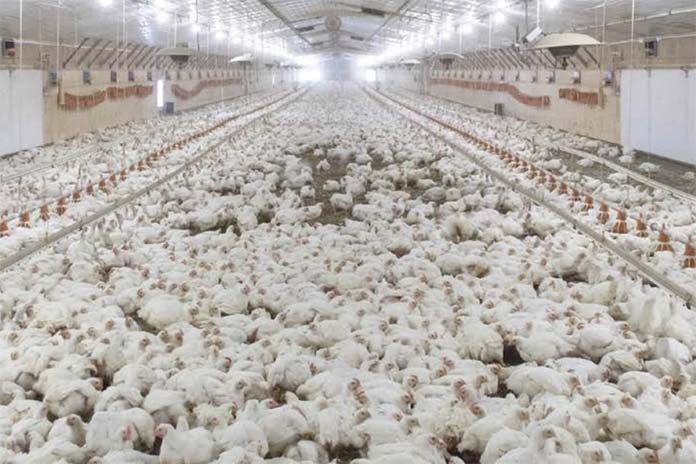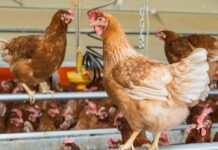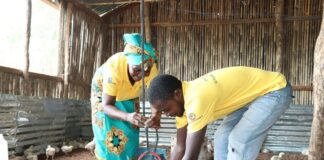
As much of the broiler industry transitions to antibiotic free production based on consumer demand, broiler house management is changing more substantially than it has for a number of years. Small tweaks in any system are easier to make than wholesale changes, and house management to ensure optimum production and bird health is adapting rapidly to the challenges put forth by this type of production system.
Traditionally in Alabama, growers placed pine shavings or peanut hulls after a complete cleanout, and then managed the used litter for six months to two years before another complete cleanout was accomplished. Complete cleanouts once a year were and are still the normal pattern of litter management. Typically, four inches of litter are placed after a complete cleanout and may or may not be top dressed between flocks. Between flocks, caked litter is removed and the house allowed to rest prior to preparing for new chick placement.
Antibiotic Free production
Antibiotics typically used in broiler feeds fall into two categories. Some, but not all, anticoccidial feed additives are classified as antibiotics, while other antibiotics are fed at low levels to maintain healthy microbial populations in the bird’s intestines and are not absorbed into the body. Other products have been in development for some time to help maintain broiler intestinal health, and poultry companies switching to antibiotic free programs are including a number of alternative feed additives in broiler feeds to maintain broiler intestinal health. Despite this, the burden of controlling intestinal health now falls even more heavily on house management conditions as antibiotics are removed.
The poultry industry has been working closely with poultry growers for decades to improve litter quality through improvements in house management and health.. Increased downtime with antibiotic free systems allows disease causing organisms more time to die off before chicks are placed for the next flock. Longer downtimes also allow time for other litter management techniques such as windrow composting to be performed. Conventional production in our area normally placed chicks seven to 14 days after the previous flock went to market. Currently, most companies producing bird in some form of an antibiotic free program use downtimes ranging from 17 to 21 days. Density has been decreased 10% in addition to increasing downtime to reduce pressure on the litter. Practical experience controlling Necrotic Enteritis has moved toward attention to detail in removing all cake. Early attempts to raise antibiotic free birds on used litter resulted in Necrotic Enteritis spread from the walls where some wet litter was left after caking out the house.
Growers now frequently cake the house shortly after the previous flock leaves. The litter is the tilled to further remove moisture. Repeated heating and ventilating of the houses during the downtime also insures adequate moisture removal prior to setting up for chicks. This last management technique is also helpful after windrow composting to remove ammonia and moisture after spreading the litter back out prior to chick placement.
Placing chicks on dry, warmed litter with ammonia controlled for the early part of the birds’ lives will help to protect the respiratory system through the birds’ most vulnerable period and also will reduce the early onset of footpad burns. Carefully-timed release of birds from brooding will insure that wet litter doesn’t occur in the brood end of the house. Good early house conditions also help foster a boost in immune function in young birds. In our area, release of birds brooding in a half-house brooding system typically occurs between 7 and 14 days – depending on season – with a release at 10 days being the most common approach. During this critical time in a flock’s life, delaying release can increase litter moisture in the brood end with little chance to remove that moisture for the remainder of the flock.
Throughout the life of the flock, continued emphasis on litter management will pay dividends in broiler health and growth. Maintaining litter depth, managing drinker systems and ventilation will promote good health when combined with vaccine programs and good nutritional programs. Proper nipple height adjustment helps keep birds from spilling water into the litter.
Clean water lines will provide the birds with fresh water without bacterial contamination that can cause microbial health problems. In addition, clean water lines will insure the efficacy of any vaccines that may be given to broilers in addition to reducing leaking nipples. For growers with wells, occasional tests to verify bacterial and mineral levels in the water provided to birds will help to avoid subclinical disease and/or wet litter caused by mineral or bacterial contamination.
Ventilation management plays a central role in moisture control and economical ventilation is a must to keep litter dry to control ammonia through as much of the flock’s life as possible. Low ammonia concentrations in the air will avoid irritation of the birds’ airways, thus reducing respiratory diseases.
Coccidiosis control
Litter management will also help to manage Coccidiosis in broilers if Coccidiosis vaccination programs are used. Coccidiosis can negatively influence growth and profitability if uncontrolled and the broiler industry has managed cocci closely for many decades for this reason. Cocci can also be a trigger for other intestinal health problems such as Necrotic Enteritis. For this reason, close control of Coccidiosis vaccine reactions will give cocci control and minimal intestinal health issues. Dry litter hampers cocci maturation and avoids increases in the amount to which birds are exposed above what is needed to foster immunity. In addition, many companies will have a liquid Coccidiosis control product on hand to treat birds if a strong Coccidiosis challenge is expected.
Litter treatments remain an important tool to control ammonia early in the flock’s life, and this emphasis has not changed with antibiotic free production in our area. Most producers are applying a litter treatment prior to chick placement and levels are aimed at reducing ammonia levels beyond brooding.
Research at Auburn has examined the use of elemental sulfur as a feed- through ammonia control product. Sulfur has shown promise as a way to reduce ammonia levels throughout the life of the flock. Litter beetle control can be a tool in controlling diseases in broiler production as litter beetles carry various bacteria and viruses both internally and externally. Beetles can spread disease through a house and farm if not controlled and can fly to neighboring farms as well. Broilers will eat litter beetles and pick up diseases directly from these pests. Along the same lines, rodents spread disease organisms in their droppings, which birds can and do eat. A well-maintained insect and rodent control program can help to avoid introducing diseases and food safety organisms into your flock.
U.S. consumers have expressed a desire for antibiotic free production of broilers and the broiler industry has responded as close to 50% of broiler companies have antibiotic free birds as a significant portion of their output. House management techniques are changing to help maintain bird health and growers will be an important part of the effort to keep birds healthy in antibiotic free programs. Keeping litter dry and reducing ammonia emissions will gain enhanced importance with today’s management systems.
From the Proceedings of the 2019 Midwest Poultry Federation Convention

















